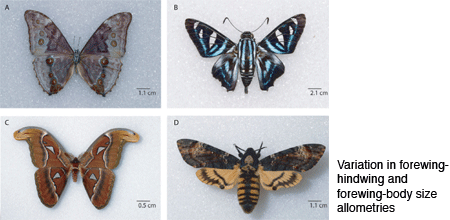- Research Overview
- Current Research
-
Previous Work
- Polyphenism Evolution: Phenotypic Plasticity and Locomotor Performance in Spadefoot Toads
- Life History Evolution: Costs of Reproduction, Offspring Size/Number Trade-Offs, and Locomotor Performance
- Morphological Scaling Relationship Evolution: Butterflies
- Ecological & Functional Morphology
- Development & Trait (Micro) Evolution

Morphological Scaling Relationship Evolution: Butterflies
Scaling relationships among functionally related traits offer an opportunity to study the roles of internal, developmental constraints and external sources of selection on morphological evolution. Among species, populations, and even sexes, morphological traits exhibit an impressive diversity of scaling relationships. This extreme variation among groups contrasts markedly to the variation within them; typically, individuals exhibit low variation around some average allometry, reflecting a tight scaling of body parts with each other and overall size. Although these patterns have been long recognized, surprisingly little is known about the evolution of scaling relationships; in particular, the relative importance of forces shaping their evolution is largely uninvestigated. Presumably, tight adherence to particular allometries results from external selection against traits with dysfunctional relative sizes. This selection is predicted to favor the evolution of genetic and developmental systems that properly scale the growth of traits across body sizes, maintaining functional size relationships in the face of environmental and genetic variation. However, this scenario presents a paradox: the proximate mechanisms that presumably evolve to maintain the relative size of traits will produce developmental constraints - constraints which must be overcome if allometries are to evolve and morphologies are to diversify.
As a postdoctoral fellow at Leiden University, I investigated the evolution of scaling relationships among elements of the functionally integrated trait suite comprised of forewing area, hindwing area, and body mass in the butterfly Bicyclus anynana. These scaling relationships are well suited for study because they are ecologically relevant, and both body size and wing size or shape are easily quantified. Through artificial selection, I produced distinct morphotypes with novel scaling relationships among these traits, shifting average trait size relative to body size (i.e., altering the intercept). Much to my surprise and that of my collaborators Paul Brakefield, Bas Zwaan, and David Stern, the scaling relationships among traits evolved easily and with a large degree of variation in the pathways taken to produce the new phenotypes. These results question the prediction that functionally integrated traits should be developmentally integrated tightly and suggest the presence of substantial variation underlying the scaling relationships themselves. Moreover, we found strong stabilizing selection favoring the wild-type scaling relationship in natural environments. In sum, findings suggest that it is externally imposed selection, not internal developmental constraints, that limit evolution of these scaling relationships.
Relevant publications
Frankino, W. A., A. Shingleton, D. Emlen. 2009. Experimental approaches to studying the evolution of morphological allometries: The shape of things to come. in: Experimental Evolution: Concepts, Methods, and Applications, T. Garland and M. Rose, eds. University of California Press.
Frankino, W. A., B. J. Zwaan, D. L. Stern, and P. M. Brakefield. 2007. Internal and external constraints in the evolution of a forewing-hindwing allometry. Evolution 61:2958-2970
Frankino, W. A., B. J., Zwaan, D. L. Stern, and P. M. Brakefield. 2007. Internal and external constraints in the evolution of a forewing-hindwing allometry. Evolution 61:2958-2970.
Shingleton, A., W. A. Frankino, T. Flatt, F. Nijhout, and D. Emlen. 2007. Size and Shape: The regulation of static allometry in insects. BioEssays 29:536-548.
Frankino, W. A., D.S. Stern, and P.M. Brakefield. 2005. Developmental constraints and natural selection in the evolution of allometries. Science 307:718-720.
P.M. Brakefield and W. A. Frankino. 2009. Polyphenisms in Lepidoptera: Multidisciplinary approaches to studies of evolution and development. in: Phenotypic Plasticity in Insects: Mechanisms and Consequences. Ananthakrishnan, TN and D. W. Whitman (Eds.). Oxford University Press.
Frankino, W. A. Experimental approaches to studying the evolution of morphological allometries: The shape of things to come. Invited submission in: Experimental Evolution: Concepts, Methods, and Applications, T. Garland and M. Rose, eds. University of California Press.